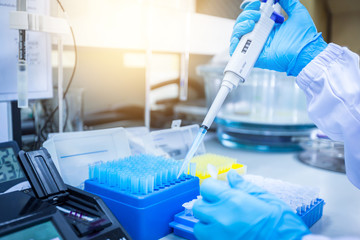A pipette is a laboratory tool used to accurately transfer or measure small amounts of liquid. The capacity of a pipette and the degree of precision with which the volume of a sample can be measured depend on its design. They are calibrated to ensure accuracy and to establish a known reference for measuring the volume of a sample. Although there are different types and sizes of pipettes, the principle of operation is the same, a small amount of liquid is aspirated into the top of the pipette and then exhaled into the bottom. Pipettes are calibrated regularly to ensure that they remain accurate.
Most pipettes require periodic calibration, which can be done by the manufacturer or a specialized laboratory. If calibration is performed in the laboratory, it is important to follow the manufacturer’s instructions to ensure that the pipette is calibrated correctly.
At Kalstein we have the best tools on the market, they are made with resistant materials to withstand any chemical that is used and must be transferred for study analysis, able to tolerate operational force and color indication to visualize the volume.
Pipette Calibration
The calibration process of a pipette involves filling the pipette with a reference solution of known density and measuring the volume to be transferred. This can be done using a Buret’s balloon or a graduated syringe. The measured volume is compared with the nominal pipette volume to determine the accuracy of the measurement.
Most pipettes are calibrated using a sodium chloride solution of known density. However, other substances such as distilled water may also be used depending on the intended use of the pipette. The accuracy of a measurement is affected by the ability of the pipette to consistently aspirate and exhale the liquid. For this reason, it is important that the pipettes are calibrated regularly to ensure that they are working properly.
The calibration of a pipette is usually performed in two stages. In the first step, the ability of the pipette to aspirate and exhale a consistent amount of liquid is measured. This is done by filling and emptying with water at a controlled temperature, and then measuring the exact volume of water that has been breathed in and out.
In the second stage, accuracy is measured by transferring a known amount of fluid. This is done by filling the pipette with water at the same temperature as used in the previous stage, and then transferring the water into a graduated container. The exact volume of water that has been transferred is measured and compared with the volume that was intended to be transferred.
Importance of Pipette Calibration
A pipette is a tool used to transfer liquids from one container to another. Their accuracy and accuracy are very important, as they are used in a variety of applications, from the manufacture of medicines to scientific research. Calibration is the process by which the accuracy and performance of the calibration is adjusted, performed using a series of liquids of known densities, which are placed in a series of vessels of known volume. The volume of liquid transferred from each vessel using the pipette is then measured and compared with the theoretical volume. This allows the error of the pipette to be determined and ultimately adjusted to work more precisely. It is very important, as poor calibration can result in incorrect fluid transfer, which in turn can cause problems in substance measurement or scientific research.
Kalstein pipettes
At Kalstein we are manufacturers and pioneers in technological applications designed for our customers. We have the Pipettes belonging to the YR series, ideal for pathological anatomy laboratories. They have a volume range of 0.1 – 2 μl. Accuracy of ±12.0 – 1.5%. Repeatability of ≤6.00 – 0.70%. Among others HERE
We are manufacturers and we have the best advice, so that your purchase is the ideal and at excellent prices. HERE




